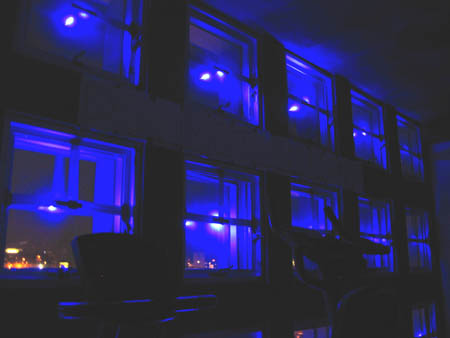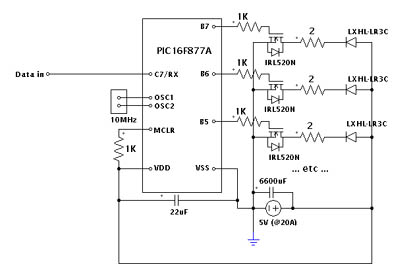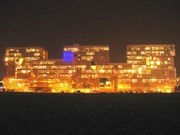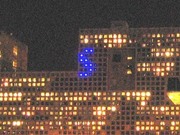Simmons LED Display
The Simmons LED Display is a home-made two-story high 6x6 array of windows outfitted with ultra-cool Luxeon LXHL-LR3C Royal Blue LEDs. It is located in the exercise room of the architecturally infamous Simmons Hall, a residence hall designed by Steven Holl that opened in 2002 for MIT's undergraduates. (Each floor is three windows high and the overall design of the building is inspired by a sponge.) It can be seen from most of Briggs Field and Dorm Row at MIT, thus making for a convenient announcement board. It follows from a vision that many Simmons Hall residents have had in the past: to turn the waffle-like arrangement of windows into working pixels. This project implemented that with under $150 of components, funded by the Simmons Rush budget. This was also done just because blue LEDs that bright (possibly the world's brightest commercially available blue LEDs?) are just cool. Below is a view of the display as seen from the inside:

Video
Low-quality video clip of the display running here (encoded with DivX).
How it works
The design is simple: each floor has a controller that consists of a PIC16F877A that switches each LED individually using IRL520N power MOSFETS. Each LED draws upto 1 amp (in this case using 2 ohm resistors for the LED's they draw somewhat less), so the power supply needs to be able to handle upto 20 A or so for each floor, since each floor is a 3x6 array. I used ATX power supplies which are happy sourcing 25 A at 5 V, but as they are switching supplies, they are bad at not browning out for a few microseconds when the load changes suddenly. This often results in the microcontroller crashing. This is resolved by adding a few large capacitors to the input (about 6600 uF are used here). Also note that the microcontroller can brown out if it is connected directly to the gates of 18 FET's, so the design here uses 1K resistors between the microcontroller and each gate. A schematic of a single controller board is shown below:

There is one of these controller boards for each of the two floors. Both listen on an RS232 "bus" through the wire labeled "Data in" above, at 9600 bps. A separate box (also powered by a PIC16F877A) sends the signals to both floors on the same wire to coordinate them to behave as a single display. It sends packets on the RS232 "bus" containing information for each floor's controller board to pick up and display its section. They are formatted as follows:
where [address] is a one-byte address assigned to the floor that is being set to a particular state described by [top row], [middle row] and [bottom row]. The controller boxes on each floor will then respond to only its own address despite the fact that all signals are going on the same bus (for simplicity). The packet is then followed by 3 bytes describing the LED's on the top, middle, and bottow rows of that floor. Of course, the first two bits of each of these bytes is irrelevant since there are only 6 pixels on each row.
Code
If you're interested in the [rather messy] code that drives the display currently, here is the code that drives a each floor's controller board, and here is sample code that coordinates two 3x6 displays into a 6x6 display to read "Welcome to Simmons". Future possibilities include an RS232 or USB interface to a computer to set the text to display, and then setting up a server through which authorized users can edit what the display does. Also, a reasonably simple language for defining arbitrary display icons (rubber ducks, happy faces, etc.) and animation should be defined. Anyone around at MIT interested in helping is welcome; contact me.
Acknowledgements
Thanks to everyone on the Simmons Rush team that helped with the installation including soldering, duct taping, and cutting. Thanks to Simmons Hall for providing the funding for this project.
FAQ
- Where is Simmons Hall? 229 Vassar Street, Cambridge, MA, USA (on the MIT campus).
- When will it be on? Probably for special events/holidays/etc. assuming MIT or the CFD doesn't require it to be taken down.
- Can I see inside? Only if you are a resident.
- Why Luxeons? Because they make powerful blue LEDs which are just plain cool. You can do this in other colours and achieve a possibly much brighter display, too.
- Why is it in the exercise room of Simmons? Simply because there is no other public space in the building that has that much of a continuous grid of windows - either a student room, strange wall, or oddly-shaped window interrupts.
Events involving the display
- 31 October 2006: Halloween!
- 13-14 October 2006: "Good Night" in several languages
- 19 September 2006: Pirate Day
- Early September 2006: "Welcome to Simmons"


